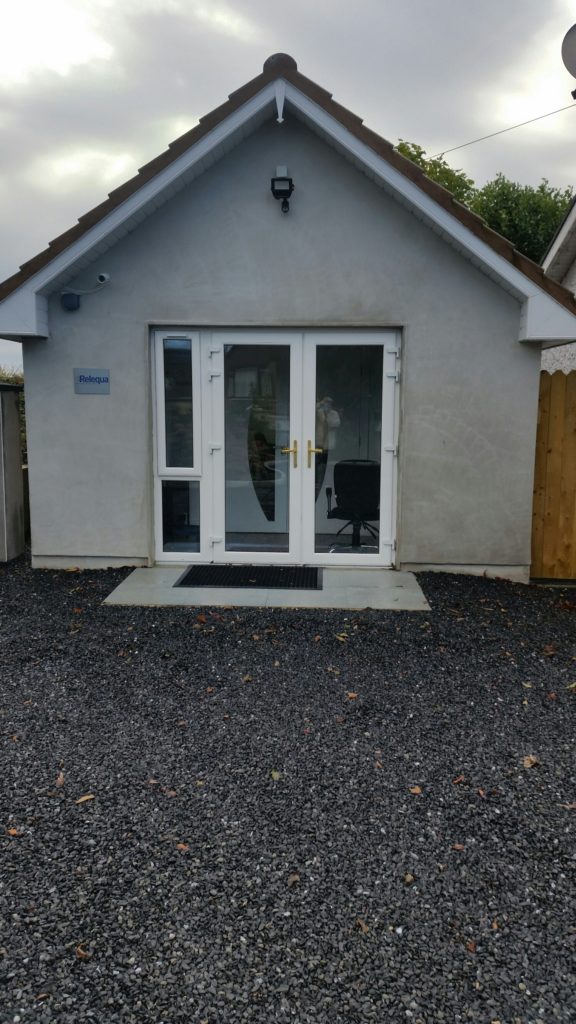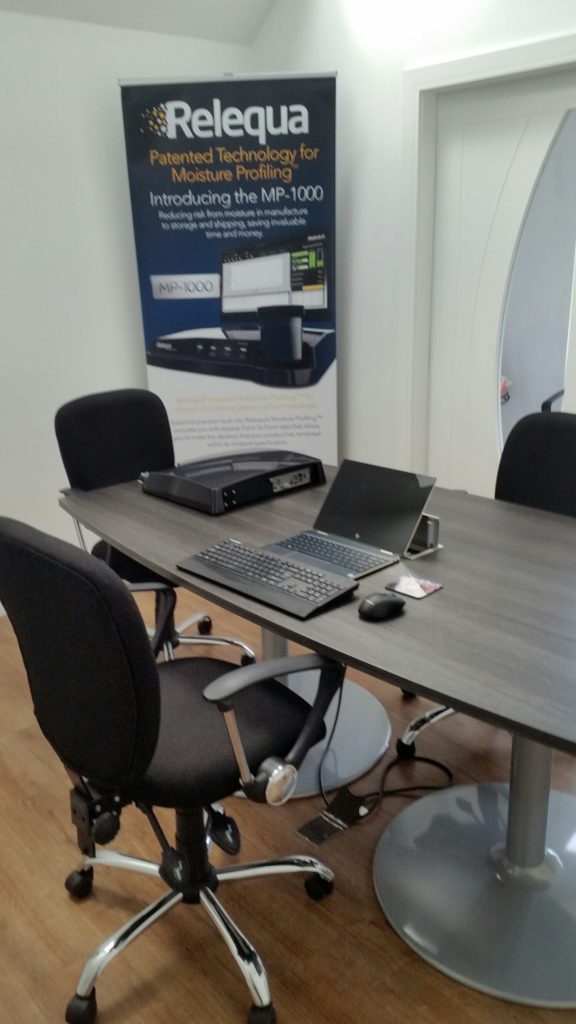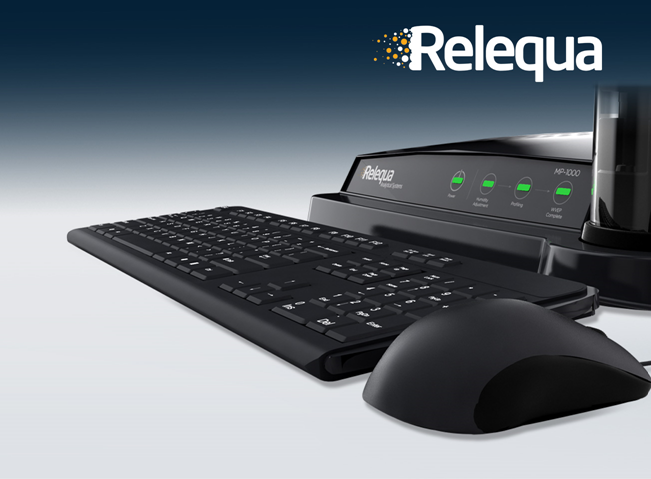A double meaning in the title. One, eventually after being very busy with Relequa I’ve found a little bit of time to publish the last episode. Two, we have completed the home for Relequa.
Back to the story. After we had thawed out after the Beast from the East the lads were back on site. Michael the Carpenter finishing off the roof, Eugene the Strong finishing off walls. In this blog, the fourth and last episode of finding Relequa a new home, I’ll take you to completion of the build to our fitted out “Alternative Alpine Lodge”.
The lads had recommended Munster Joinery, an Irish windows and doors company, that has built itself from a start-up in Munster to a large international company, supplying and fitting their products across Ireland and the UK. We were soon ready to act upon the quote from Munster Joinery. The Beast from the East did set a lot of people back and we had to wait longer than we expected for the windows and doors to arrive. But, arrive they did, and no problems with fitting. Surprisingly quick actually, with the fitters going off to another job on the same day.

Windows and doors in place we were on another cycle of Michael the Carpenter, Kieran the Plasterer and Mícheál the Electrician. Time now to introduce you to our last character, Gregor the Tiler, a giant of a man from Poland. Gregor the Tiler didn’t talk much. Three areas were planned for tiling; reception, toilet and my office come “sun” room.
The next sequence of events within my “sun” room was more or less the same as the garage refit with timber, plasterboard and plastering stages. While this was going on, I started painting the ceiling of what was to become the meeting room. After three coats of paint I surrendered and we got in painters. Apparently, I was using the wrong paint for the light in the room!
Apart from drying plaster that I talked about in Episode 3, there was nothing inside or outside relating to moisture to explore further in my “world of Moisture Matters”. Not until we were fully fitted out did an interesting moisture issue arise.

As well as making our Relequa Moisture Profiling System, we also get involved in project work. Our first project was for a company called Sepha who make small scale pharmaceutical equipment for R&D laboratories and Clinical Trial manufacture and packing of tablets and capsules.
Sepha had just launched their new invention for testing how good the foil seal is (“integrity”) on blister packs. Up until this invention, pharmaceutical manufacturers had to take a statistical sample of blisters from a batch and test the “integrity” of the seal using a machine that forces dye into the blister pockets. Blister pockets picking up the dye would fail the test. This dye test, used for many, many years, works on the principle of having a significant fraction of the batch of blisters not failing, and so the rest of the batch is passed for use. Sepha’s new machine called VisionScan, uses a technique which allows 100% of the blisters in a batch to be checked for leaks without damaging the tablet or capsule in the pocket, or the blister pack itself.
The project with Relequa was devised to use moisture movement as a way for testing the “integrity” of blisters after treatment with VisionScan. If treatment affected the “integrity” of the blister seal then moisture would be taken up by a tablet inside the pocket. A gain in moisture of a tablet is easily detected using our Relequa Moisture Profiling System. Moisture Profiling of tablets was done before and after VisionScan treatment and then over a period of several weeks after storing the blisters at high humidity.
We showed that the tablets we chose could easily pick up moisture and this, if occurred, would be detected in tablets from VisionScan treated blisters. No difference in tablet moisture was seen between the tablets from blisters treated by VisionScan compared to untreated blisters. The conclusion was that the VisionScan treatment had no impact on the “integrity” of the seal. This project was written up by an independent author at Ulster University as a whitepaper in the European Journal of Pharmaceutical Science and is free to download.
Earlier I mentioned an interesting issue that came up. Due to technical reasons around making tablets, that I’ll not go into here, we chose to make the tablets for the Sepha project from a sugar called Xylitol. When the Sepha project was completed, I obtained the bulk of the tablets that were not packed into blisters. My intention was to use these for calibrating the MP-1000, our new Relequa Moisture Profiling System.

Customers who have bought an MP-1000 can check if the system is functioning as it should. To do this we supply them with tablets from a batch that we have already tested. These tablets are sealed in a moisture resistant pack. The pack is a bag made with a high moisture-barrier material. We put in a number of tablets and heat seal the bag.
Before releasing the calibration tablets for use, the sealed bags were put into high humidity conditions and at weekly intervals a bag was removed, the tablets taken out and immediately checked on the MP-1000. What happened next was unexpected.
Using my many years of experience working with moisture issues, I knew from i) the starting condition of the tablets, ii) the quality of moisture-barrier material of the bag and iii) the ambient humidity, that no moisture transfer should occur over the time the bags were stored. However, I couldn’t argue with data that clearly showed that the tablets from the sealed bags were picking up moisture. So what on earth was going on?
At times, to solve a problem, it’s only about using “all” the information that’s available to you, even when it’s not directly related to the thing you are investigating. When you hear the answer, you’ll probably think “of course it’s related” but that is the power of hindsight.
Back to the Sepha project for a clue. As part of the testing protocol I built in what is known as a “positive control”. Using a hypodermic needle, a tiny hole was put into some of the blister pockets of the packed Xylitol tablets. These were placed, along with the other blister packs, at high humidity. After a week the tablets from the pockets with a hole had dramatically picked up moisture. Other tablets from intact pockets were unchanged. When attempting to test the tablets from the pockets with a hole that had been at high humidity for two weeks, no testing could be done because the tablets had turned to mush!
That mush was the clue. Our Xylitol tablets were undergoing deliquescence, a property of salts and sugars that I’ve talked about before on my blog posts. These tablets were chosen because of their ability to take up moisture. Where this was an effective property for the Sepha project, it was too effective for using the same tablets as a stable source of moisture calibration material.
The moisture barrier bags, in which the Xylitol tablets were packed as calibration tablets, are only moisture resistant and not an absolute barrier to moisture transfer. With the external humidity fluctuating around 65% RH a small amount of moisture passed through the material of the bag. The driving force for this to happen is that the tablets are continuously absorbing moisture as they move towards deliquescence.
My only option was to have different types of tablets prepared and start again with a moisture testing time course experiment.
Welcome to my world of moisture
Next topic: Life on Mars.
If you would like to hear more about moisture and humidity in everyday life, please sign up for email alerts of my blogs.

Leave a Reply